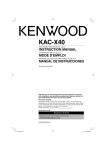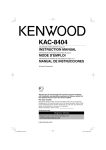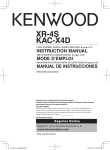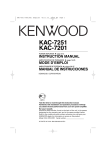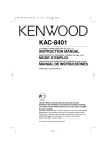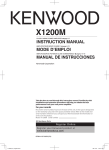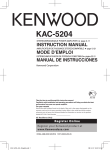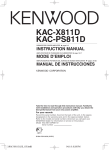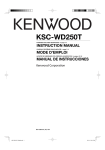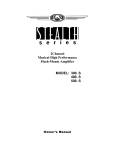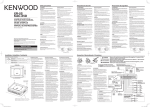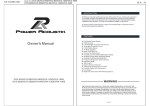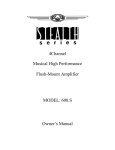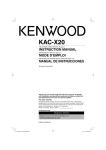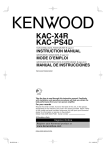Download Kenwood X600F Stereo Amplifier User Manual
Transcript
X600F FOUR CHANNEL POWER AMPLIFIER 7 page 2-7 INSTRUCTION MANUAL AMPLIFICATEUR 4 CANAUX 7 page 8-13 MODE D’EMPLOI AMPLIFICADOR DE POTENCIA DE CUATRO CANALES 7 página 14-19 MANUAL DE INSTRUCCIONES Take the time to read through this instruction manual. Familiarity with installation and operation procedures will help you obtain the best performance from your new power amplifier. For your records Record the serial number, found on the back of the unit, in the spaces designated on the warranty card, and in the space provided below. Refer to the model and serial numbers whenever you call upon your Kenwood dealer for information or service on the product. Model X600F Serial number US Residence Only Register Online Register your Kenwood product at www.kenwoodusa.com © B64-4199-00/00 (KV) X600F_K_1English.indd 1 08.10.21 1:34:14 PM Safety precautions WARNING Cleaning the unit To prevent injury or fire, take the following precautions: • Mounting and wiring this product requires skills and experience. For safety’s sake, leave the mounting and wiring work to professionals. • When extending the ignition, battery, or ground wires, make sure to use automotive-grade wires or other wires with the range of 14 mm2 (AWG 6) to 21 mm2 (AWG 4) to prevent wire deterioration and damage to the wire coating. • To prevent a short circuit, never put or leave any metallic objects (such as coins or metal tools) inside the unit. • If the unit starts to emit smoke or strange smells, turn off the power immediately and consult your Kenwood dealer. • Do not touch the unit during use because the surface of the unit becomes hot and may cause burns if touched. CAUTION To prevent damage to the machine, take the following precautions: • Be sure the unit is connected to a 12V DC power supply with a negative ground connection. • Do not open the top or bottom covers of the unit. • Do not install the unit in a spot exposed to direct sunlight or excessive heat or humidity. Also avoid places with too much dust or the possibility of water splashing. • When replacing a fuse, only use a new one with the prescribed rating. Using a fuse with the wrong rating may cause your unit to malfunction. • To prevent a short circuit when replacing a fuse, first disconnect the wiring harness. NOTE • If you experience problems during installation, consult your Kenwood dealer. • If the unit does not seem to be working right, consult your Kenwood dealer. FCC WARNING This equipment may generate or use radio frequency energy. Changes or modifications to this equipment may cause harmful interference unless the modifications are expressly approved in the instruction manual. The user could lose the authority to operate this equipment if an unauthorized change or modification is made. FCC NOTE This equipment has been tested and found to comply with the limits for a Class B digital device, pursuant to Part 15 of the FCC Rules. These limits are designed to provide reasonable protection against harmful interference in a residential installation. This equipment may cause harmful interference to radio communications, if it is not installed and used in accordance with the instructions. However, there is no guarantee that interference will not occur in a particular installation. If this equipment does cause harmful interference to radio 4Ω off or television reception, which can be determined by turning the equipment and on, the user is encouraged to try to correct the interference by one or more 4Ω of the following measures: • Reorient or relocate the receiving antenna. • Increase the separation between the equipment and receiver. • Connect the equipment into an outlet on a circuit different from that to 4Ω which 4Ω the receiver is connected. 4Ω 4Ω • Consult the dealer or an experienced radio/TV technician for help. 4Ω If the front panel gets dirty, turn off the power and wipe the panel with a dry silicon cloth or soft cloth. CAUTION Do not wipe the panel with a hard cloth or a cloth dampened by volatile solvents such as paint thinner and alcohol. They can scratch the surface of the panel and/or cause the indicator letters to peel off. To prevent battery rise When the unit is used in the ACC ON position without turning the engine ON, it depletes the battery. Use it after starting the engine. Protection function The protection function is activated in the following situations: This unit is equipped with a protection function for protecting this unit and your speakers from various accidents or problems that can occur. When the protection function is triggered, the PROTECTION indicator lights and the amplifier stops operating. • When a speaker wire may be short-circuited. • When a speaker output contacts ground. • When the unit malfunctions and a DC signal is sent to the speaker output. Wiring • Take the battery wire for this unit directly from the battery. If it’s connected to the vehicle’s wiring harness, it can cause blown fuses etc. • If a buzzing noise is heard from the speakers when the engine is running, connect a line noise filter (optional) to each of the battery wire. • Do not allow the wire to directly contact the edge of the iron plate by using Grommets. • Connect the ground wire to a metal part of the car chassis that acts as an electrical ground passing electricity to the battery‘s negative · terminal. Do not turn the power on if the ground wire is not connected. • Be sure to install a protective fuse in the power cord near the battery. The protective fuse should be the same capacity as the unit’s fuse capacity or somewhat larger. • For the power cord and ground, use a vehicle type (fireproof ) power wring cord with a current capacity greater than the unit’s fuse capacity. (Use a power wiring cord with the range of 14 mm2 (AWG 6) to 21 mm2 (AWG 4). • When more than one power amplifier are going to be used, use a power supply wiring wire and protective fuse of greater current-handling capacity than the total maximum current drawn by each amplifier. Speaker Selection • The rated input power of the speakers that are going to be connected should be greater than the maximum output power (in Watts) of the amplifier. Use of speakers having input power ratings that are less than the output power of the amplifier will cause smoke to be emitted as well as damage. • Use speakers that have an impedance of 2Ω or greater. When more than one set of speakers are going to be used, calculate the combined impedance of the speakers and then connect suitable speakers to the amplifier. 4Ω 4Ω 4Ω 4Ω 2Ω 8Ω 4Ω Combined impedance 4Ω 4Ω 4Ω 4Ω 4Ω 4Ω 4Ω 4Ω 8Ω 2Ω NOTE This Class B digital apparatus complies with Canadian ICES-003. English X600F_K_1English.indd 2 08.10.21 1:34:15 PM Installation Accessories ø6 Part name 380 mm 320 mm 286 mm 272 mm Hexagon Wrench (Small) Hexagon socket head cap screw (M4 × 8 mm) Dressing cover Cooling fan Self-tapping screw (ø5 × 18 mm) External View Number of Items Self-tapping screws (ø5 × 18 mm) 4 Hexagon Wrench (Large) 1 Hexagon Wrench (Small) 1 Terminal cover (Power terminal) 1 Installation procedure Since there are large variety of settings and connections possible according to applications, read the instruction manual well to select the proper setting and connection. 1. Remove the ignition key and disconnect the negative · terminal of the battery to prevent short circuits. 2. Set the unit according to the intended usage. 3. Remove the Dressing cover. 4. Connect the input and output wires of the units. 5. Connect the speaker wires. 6. Connect the power wire, power control wire and grounding wire following this order. 7. Install the installation fittings in the unit. 8. Attach the unit. 9. Attach the Dressing cover. 10.Connect the negative · terminal of the battery. CAUTION • Do not install in the below locations; (Unstable location, In a location that interferes with driving, In a location that gets wet, In a dusty location, In a place that gets hot, In a place that gets direct sunlight, In a location that gets hit by hot air) • Do not install the unit under the carpet. Otherwise heat build-up occurs and the unit may be damaged. • Install this unit in a location which allows heat to easily dissipate. Once installed, do not place any object on top of the unit. • The surface temperature of the amplifier will become hot during use. Install the amplifier in a place where people, resins, and other substances that are sensitive to heat will not come into contact with it. • This unit has cooling fan to decrease the internal temperature. Do not mount the unit in a place where the cooling fan and ducts of the unit are blocked. Blocking these openings will inhibit the cooling of the internal temperature and result in malfunction. • When making a hole under a seat, inside the trunk, or somewhere else in the vehicle, check that there is nothing hazardous on the opposite side such as a gasoline tank, brake pipe, or wiring harness, and be careful not to cause scratches or other damage. • Do not install near the dashboard, rear tray, or air bag safety parts. • The installation to the vehicle should securely fasten the unit to a place in which it will not obstruct driving. If the unit comes off due to a shock and Installation board, etc. hits a person or safety part, it may cause injury or an accident. (thickness : 15 mm or more) • After installing the unit, check to make sure that electrical equipment such as the brake lamps, turn signal lamps and windshield wipers operate normally. English X600F_K_1English.indd 3 08.10.21 1:34:17 PM Connection WARNING Remove the ignition key and disconnect the negative · terminal of the battery to prevent short circuits. RCA cable* CENTER UNIT (CD receiver, etc.) NOTE Hexagon Wrench (Small) Power control wire* Use the attached Hexagon Wrench. CAUTION • If sound is not output normally, immediately turn power off and check connections. • Be sure to turn the power off before changing the setting of any switch. • If the fuse blows, check wires for shorts, then replace the fuse with one of the same rating. • Check that no unconnected wires or connectors are touching the car body. Do not remove caps from unconnected wires or connectors to prevent short circuits. • Connect the speaker wires to appropriate speaker connectors separately. Sharing the negative wire of the speaker or grounding speaker wires to the metal body of the car can cause this unit to fail. • After installation, check that the brake lamps, winkers, and wipers work properly. Hexagon Wrench (Small) BATT. GND LEFT RIGHT LEFT Left input RIGHT L R FUSE [30Ax2] P.CON BRIDGED SPEAKER OUTPUT A BRIDGED SPEAKER OUTPUT Hexagon Wrench (Large) B A LINE IN B A channel input A + B LINE OUT Right input B channel input Use the attached Hexagon Wrench. Battery wire* B channel Right speaker Protective Fuse* B channel Left speaker * Commercially available parts A channel Right speaker Terminal cover WARNING To prevent fire caused by a short in the wiring, connect a fusible link or breaker nearby the battery’s positive terminal. Use a RCA cable with a straight terminal. If a RCA cable with L type terminal is used, it may not be able to connect. A channel Left speaker Battery Ground wire* LEFT RIGHT BRIDGED SPEAKER OUTPUT A LEFT RIGHT BRIDGED SPEAKER OUTPUT B Bridged Connections B channel Speaker (Bridged) A channel Speaker (Bridged) About the Lead Terminals 1.Wire Thicknesses You can use wires with the following thicknesses: Battery wire and ground wire AWG 4 – AWG 6 Speaker wire AWG 8 – AWG 12 10 - 13 mm (3/8" - 1/2") Hexagon Wrench (Large) Hexagon Wrench (Small) 2.Strip the wire Make a cut in the wire sheath (insulator made from vinyl, etc.) at the position 10-13 mm away from the end of the wire, and then remove the unnecessary portion of the sheath by twisting it. 3.Install the wire Loosen the screw using the supplied hexagon wrench. Insert the conductor of the wire in the terminal hole, and then tighten the screw. English X600F_K_1English.indd 4 08.10.21 1:34:18 PM System examples 4-channel system CENTER UNIT 1 2 3 4 [MIN] 5 70 0.5 L L A R R Front Left speaker L L B R R Rear Left speaker Front Right speaker 2 150 3 4 200 [MIN] 5 HPF/LPF FREQUENCY[Hz] 50 60 0.5 0.3 4 6 100 BASS BOOST FREQUENCY[Hz] 70 10 2 0 18 50 BASS BOOST LEVEL[dB] 1 200 HPF/LPF FREQUENCY[Hz] 70 [MIN] 5 2 0.2 [MAX] 50 INPUT SENSITIVITY[V] 150 3 4 200 [MIN] 5 HPF/LPF FREQUENCY[Hz] 60 0.5 0.3 INPUT SENSITIVITY[V] 70 80 4 6 50 60 0.5 0.3 0.2 [MAX] 40 INPUT SENSITIVITY[V] 70 80 4 6 100 BASS BOOST FREQUENCY[Hz] 70 10 2 100 15 60 90 0 18 150 50 BASS BOOST LEVEL[dB] 200 HPF/LPF FREQUENCY[Hz] B ch B ch FILTER HPF OFF A B LPF 100 BASS BOOST FREQUENCY[Hz] A ch 70 10 2 CENTER UNIT 0 18 BASS BOOST LEVEL[dB] 1 100 15 60 90 0.2 [MAX] 40 200 [MIN] 5 HPF/LPF FREQUENCY[Hz] Subwoofer (Bridged) 50 3 4 [Lch] Right speaker (High pass) 1 100 2 150 INPUT A ch SELECTOR OPERATION FILTER MONO HPF A Left speaker (High pass) L L B R R 60 1 100 OFF LPF STEREO LPF 2-channel + Subwoofer system (2) L L A R R CENTER UNIT Right speaker (Bridged) OFF LPF STEREO L L B R R 60 0.3 0.2 [MAX] 50 INPUT SENSITIVITY[V] Left speaker (Bridged) A ch 2-channel + Subwoofer system (1) 0.3 [MIN] 5 70 0.5 L L A R R B ch FILTER HPF OFF A B 0.5 3 4 B ch [Lch] 1 R 2 150 INPUT A ch SELECTOR OPERATION FILTER MONO HPF A 2 CENTER UNIT 100 15 60 90 0.2 [MAX] 40 INPUT SENSITIVITY[V] 70 80 A ch 3 4 L Rear Right speaker 1 100 60 0.3 0.2 [MAX] 50 INPUT SENSITIVITY[V] High-power 2-channel system 150 50 200 HPF/LPF FREQUENCY[Hz] INPUT A ch SELECTOR OPERATION FILTER MONO HPF A [Lch] B ch FILTER HPF OFF STEREO 0.5 0.3 [MIN] 5 L L B R R Subwoofer (Bridged) Right speaker (High pass) 1 100 2 60 0.2 [MAX] 50 INPUT SENSITIVITY[V] Left speaker (High pass) 150 3 4 200 [MIN] 5 HPF/LPF FREQUENCY[Hz] 50 60 0.5 0.3 0.2 [MAX] 40 INPUT SENSITIVITY[V] LPF 70 80 4 6 100 BASS BOOST FREQUENCY[Hz] 100 15 60 0 18 BASS BOOST LEVEL[dB] 150 50 200 HPF/LPF FREQUENCY[Hz] B ch INPUT A ch SELECTOR OPERATION FILTER MONO HPF A [Lch] B ch FILTER HPF OFF OFF LPF 70 10 2 90 A ch B ch A B 70 2 3 4 L L A R R A B STEREO LPF OFF LPF English X600F_K_1English.indd 5 08.10.21 1:34:19 PM Controls 1 2 3 4 [MIN] 5 Z 70 0.5 60 0.3 0.2 [MAX] 50 INPUT SENSITIVITY[V] 1 100 2 150 3 4 200 [MIN] 5 HPF/LPF FREQUENCY[Hz] 60 50 0.5 0.3 0.2 [MAX] 40 INPUT SENSITIVITY[V] 70 80 6 4 BASS BOOST FREQUENCY[Hz] A ch 70 10 2 100 15 60 90 100 0 18 BASS BOOST LEVEL[dB] 150 50 200 HPF/LPF FREQUENCY[Hz] B ch INPUT A ch SELECTOR OPERATION FILTER MONO HPF A B ch FILTER HPF [Lch] OFF A B STEREO LPF OFF LPF NOTE The control panel locates under the front side cover. Remove the cover to access to its controls for adjustment. (See page 3) THERMAL MANAGEMENT BATT. GND LEFT LEFT RIGHT PROTECTION RIGHT L R FUSE [40Ax2] 1 Fuse (40 A x 2) NOTE If you can’t find the specified capacity fuse at your store etc., consult your Kenwood dealer. 2 Battery terminal 3 Power control terminal Controls the unit ON/OFF. NOTE Controls the unit power. Be sure to connect it with all the systems. 4 Ground terminal 5 Speaker output terminals (A.ch/B.ch) •Stereo Connections: When you wish to use the unit as a stereo amplifier, stereo connections are used. The speakers to be connected should have an impedance of 2Ω or greater. When multiple speakers are to be connected, ensure that the combined impedance is 2Ω or greater for each channel. •Bridged Connections: When you wish to use the unit as a high-output monaural amplifier, bridged connections are used. (Make connections to the LEFT channel 9 and the RIGHT channel · SPEAKER OUTPUT terminals.) The speakers to be connected should have an impedance of 4Ω or greater. When multiple speakers are to be connected, ensure that the combined impedance is 4Ω or greater. These jacks output respectively the signals input to amplifiers A and B. BRIDGED SPEAKER OUTPUT A This is a 4 channel amplifier including 2 stereo amplifiers in a body. One amplifier is referred to as amplifier A and the other is amplifier B. This unit is compatible with a large variety of systems by combining the switches and functions described in the following. 6 LINE IN terminal (A.ch/B.ch) 7 LINE OUT terminal BRIDGED SPEAKER OUTPUT P.CON B They always output the stereo signals regardless of the position of the "OPERATION" switch. 8 THERMAL MANAGEMENT indicator Lights this indicator when the internal temperature is high. 9 PROTECTION indicator Lights this indicator when the protection function is activated. (See page 2) 0 Power indicator When the power is turned on, the Power indicator lights. - INPUT SENSITIVITY control (A.ch/B.ch) Set this control according to the pre-output level of the center unit connected with this unit. The sensitivities of amplifiers A and B can be adjusted independently regardless of the position of the input selector switch. NOTE For the pre-output level, refer to the <Specifications> in the instruction manual of the center unit. = HPF/LPF FREQUENCY control (A.ch/ B.ch) Sets the cutoff frequency when the "FILTER" switch is set to "HPF" or "LPF". A LINE IN B A + B LINE OUT # OPERATION switch The amplification methods of the signals input can be selected. •STEREO position: The amplifier can be used as a stereo amplifier. •MONO (Lch) position: Amplifies the signal input from the left side only. Set to this position and make bridged connections to use as a high-power monaural amplifier. (The input right signal is not output.) $ FILTER switch (A.ch/B.ch) This switch allows to apply high-pass or low-pass filtering to the speaker outputs. •HPF (High-Pass Filter) position: The filter outputs the band of higher frequencies than the frequency set with the "HPF FREQUENCY" control. •OFF position: The entire bandwidth is output without filtering. •LPF (Low-Pass Filter) position: The filter outputs the band of lower frequencies than the frequency set with the "LPF FREQUENCY" control. The speaker output is automatically switched to monaural (L+R). ~ BASS BOOST FREQUENCY control (B.ch) Sets the center frequency around which the low frequency range should be boosted. ! BASS BOOST LEVEL control (B.ch) Sets the level by which the low frequency range should be boosted. @ INPUT SELECTOR switch This switch selects the input method of the signals to be amplified by amplifiers A and B. •A B position: Amplifies both of the signals input to amplifiers A and B. •A position: Amplifies only signal input amplifier A with both amplifiers A and B. English X600F_K_1English.indd 6 08.10.21 1:34:21 PM Troubleshooting Guide What might appear to be a malfunction in your unit may just be the result of slight misoperation or miswiring. Before calling service, first check the following table for possible problems. PROBLEM POSSIBLE CAUSE No sound. (Blown fuse.) • Input (or output) cables are disconnected. • Protection circuit may be activated. • Volume is too high. • The speaker cord is shorted. The output level is too small (or too large). The sound quality is bad. (The sound is distorted.) • The input sensitivity adjusting control is not set to the correct position. • The speakers wire are connected with wrong ª / · polarity. • A speaker wire is pinched by a screw in the car body. • The switches may be set improperly. SOLUTION • Connect the input (or output) cables. • Check connections by referring to <Protection function>. • Replace the fuse and use lower volume. • After check the speaker cord and fixing the cause of the short, replace the fuse. • Adjust the control correctly referring to <Controls>. • Connect them properly checking the ª / · of the terminals and wires well. • Connect the speaker wire again so that it is not pinched by anything. • Set switches properly by referring to <Controls>. Specifications Specifications subject to change without notice. CEA-2006 RMS Watts per channel @ 4 ohms, 1 % THD+N........................................................................................................................................................................100 W × 4 Signal to Noise Ratio (Reference : 1 Watt into 4 ohms)............................................................................................................................................................... 85 dBA Audio Section Max Power Output..........................................................................................................................................................................................................................................1200 W Rated Power Output (+B = 14.4 V) Normal (4 Ω) (20 Hz – 20 kHz, 0.05 % THD)..................................................................................................................................................................100 W × 4 (2 Ω) (1 kHz, 0.5 % THD).........................................................................................................................................................................................150 W × 4 Bridged (4 Ω) (1 kHz, 0.5 % THD)........................................................................................................................................................................................300 W × 2 Frequency Response (+0, –3 dB)............................................................................................................................................................................................... 5 Hz – 50 kHz Sensitivity (rated output) (MAX.) .................................................................................................................................................................................................................0.2 V (MIN.) . .................................................................................................................................................................................................................5.0 V Input Impedance................................................................................................................................................................................................................................................ 10 kΩ Signal to Noise Ratio.......................................................................................................................................................................................................................................105 dB Low Pass Filter Frequency (-12 dB/oct.)................................................................................................................................................................50 – 200 Hz (variable) High Pass Filter Frequency (-12 dB/oct.)..............................................................................................................................................................50 – 200 Hz (variable) Bass Boost Level (B channel).........................................................................................................................................................................................0 – +18 dB (variable) Bass Boost Frequency (B channel)...........................................................................................................................................................................40 – 100 Hz (variable) General Operating Voltage............................................................................................................................................................................................... 14.4 V (11 – 16 V allowable) Current Consumption......................................................................................................................................................................................................................................... 64 A Installation Size (W × H × D)..........................................................................................................................................................................................380 × 66 × 286 mm ................................................................................................................................................................................................................14-15/16 × 2-5/8 × 11-1/4 inch Weight.................................................................................................................................................................................................................................................4.9 kg (10.8 lbs) English X600F_K_1English.indd 7 08.10.21 1:34:22 PM Précautions de sécurité AVERTISSEMENT Nettoyage de l’appareil Si la surface de l’appareil sale, l’essuyer avec un chiffon au silicone ou un chiffon doux et sec après avoir éteint l’appareil. Pour éviter toute blessure et/ou incendie, veuillez prendre les précautions suivantes: ATTENTION • Le montage et le câblage de ce produit nécessite des compétences et de l'expérience. Pour des raisons de sécurité, laissez un professionnel effectuer le travail de montage et de câblage. • Si vous prolongez un câble de batterie ou de masse, assurez vous d'utiliser un câble pour automobile ou un câble compris entre 14 mm2 (AWG 6) et 21 mm2 (AWG 4) afin d'éviter tout risque de détérioration ou d'endommagement du revêtement des câbles. • Pour éviter les court-circuits, ne jamais mettre ou laisser d'objets métalliques (comme une pièce de monnaie ou un outil en métal) à l'intérieur de l'appareil. • Si l'appareil commence à émettre de la fumée ou une odeur bizarre, mettez immédiatement l'appareil hors tension et consultez un revendeur Kenwood. • Ne pas toucher l’appareil quand il est en service car la température de sa surface est suffisamment élevée pour provoquer des brûlures. N'essuyez pas le panneau avec un tissu rugueux ou imprégné de dissolvant volatile comme un diluant à peinture ou de l'alcool. Il pourrait rayer la surface du panneau et/ou écailler les lettres d'informations. Comment éviter une élévation de la batterie Lorsque l’unité est utilisée avec l’ACC sur ON, sans que le moteur ne soit allumé, cela décharge la batterie. Il est préférable de l’utiliser après avoir allumé le moteur. Fonction de protection La fonction de protection se met en service dans les cas suivants Cet appareil est pourvu d’une fonction de protection de l’appareil lui-même et des haut-parleurs de manière à éviter divers incidents. Lorsque la fonction de protection s’active, l’indicateur PROTECTION s’allume et l’amplificateur s’arrête. • Si un cordon de liaison aux haut-parleurs est en court-circuit. • Une sortie de haut-parleur est mise à la masse. • Une tension continue est appliquée sur les sorties vers les haut-parleurs en raison d’un défaut de fonctionnement de l’appareil. ATTENTION Pour éviter tout dommage à l'appareil, veuillez prendre les précautions suivantes: • Bien vérifier que l’appareil est raccordé à une source d’alimentation CC de 12 V avec raccordement de masse négative. • N'ouvrez pas le couvercle supérieur ou inférieur de l'appareil. • N'installez pas l'appareil dans un endroit exposé directement à la lumière du soleil, à une chaleur excessive ou à l'humidité. Evitez aussi les endroits trop poussiéreux et où l'appareil risque d'être éclaboussé. • Lors du remplacement d'un fusible, utilisez seulement un fusible neuf avec la valeur indiquée. L'utilisation d'un fusible d'une valeur différente peut être la cause d'un mauvais fonctionnement de votre appareil. • Pour éviter les courts-circuits lors du remplacement d'un fusible, déconnectez d'abord le faisceau de câbles. Câblage • Pour cette unité, brancher le cordon de la batterie directement à la batterie. Si celui-ci est connecté à l’installation électrique du véhicule, l’installation peut disjoncter etc. • Si un ronronnement se fait entendre dans les haut-parleurs lorsque le moteur tourne, fixer un filtre antiparasite de ligne (en option) au câble de la batterie. • Utiliser un passe-câble de manière que le cordon ne soit pas en contact avec le tablier. • Relier les fils de masse à une partie métallique du châssis du véhicule qui soit en mesure de jouer le rôle de masse électrique et donc de laisser passer le courant vers le pôle négatif · de la batterie. Ne pas mettre l’appareil sous tension si les fils de masse ne sont pas reliés. • Assurez-vous de mettre en place un fusible protégeant le cordon d’alimentation situé près de la batterie. Ce fusible doit avoir un pouvoir de coupure égal ou légèrement supérieur à celui de l’unité. • En ce qui concerne le cordon d’alimentation et la terre, il est conseillé d’utiliser un cordon d’alimentation électrique pour voiture (ininflammable) dont l’intensité sera supérieure au pouvoir de coupure du fusible de l’unité. (Utiliser un cordon d’alimentation d’un diamètre compris entre 14 mm2 (AWG 6) et 21 mm2 (AWG 4).) • Lorsque plus d’un amplificateur de puissance doivent être utilisés, utiliser un câble de câblage d’alimentation et un fusible de sécurité dont la limite de tension est supérieure au courant total maximum tiré par chaque amplificateur. REMARQUE • Si vous rencontrez des problèmes pendant l'installation, consultez votre revendeur Kenwood. • Si l'appareil semble ne pas fonctionner correctement, consultez votre revendeur Kenwood. REMARQUE Cet appareil numérique de la classe B est conforme à la morme NMB-003 du Canada. Sélection des haut-parleur • La puissance d’entrée nominale des haut-parleur qui vont être connectées doit être supérieure à la puissance de sortie maximum (en Watts) de l’amplificateur. L’utilisation d’haut-parleur dont la puissance d’entrée nominale est inférieure à la puissance de sortie de l’amplificateur entraînera l’émission de fumée, ainsi que des dommages. • Utiliser des haut-parleur dont l’impédance est de minimum 2Ω. Lorsque plus d’un jeu d’haut-parleur va être utilisé, calculer l’impédance combinée des haut-parleur et connecter ensuite les haut-parleur appropriées à l’amplificateur. 4Ω 4Ω 4Ω 4Ω 4Ω 4Ω 4Ω 2Ω 8Ω 4Ω 4Ω 4Ω 4Ω 4Ω Impédance combinée 4Ω 4Ω 4Ω 4Ω 4Ω 4Ω 4Ω 4Ω 8Ω 2Ω Frençais X600F_K_2French.indd 8 08.10.21 3:46:34 PM Installation Accessoires ø6 380 mm 320 mm Nom de la pièce 286 mm 272 mm Vis d’assemblage à six pans creux (M4 × 8 mm) Clé polygonale (petite) Enjoliveur Vue extérieure Quantité Vis taraudeuses (ø5 × 18 mm) 4 Clé polygonale (grand) 1 Clé polygonale (petite) 1 Cache de bornier (Borne d’alimentation) 1 Procédure d'installation Etant donné que le nombre de réglages et de raccordements est assez important, il importe de prendre pleinement connaissance du mode d'emploi. 1. Retirer la clé de contact et débrancher la borne négative · de la batterie pour éviter les court-circuits. 2. Régler l'appareil en fonction de l'utilisation désirée. 3. Déposer l’enjoliveur. 4. Raccorder les câbles d’entrée et de sortie de l’appareil. 5. Raccorder les câbles de haut-parleur. 6. Relier, dans l'ordre, le câble d'alimentation, le câble de commande d'alimentation et le câble de masse. 7. Mettre en place les accessoires d’installation sur l’unité. 8. Brancher l’unité. 9. Fixer l’enjoliveur. 10.Raccorder la borne négative · de la batterie. ATTENTION Ventilateur de refroidissement Vis taraudeuse (ø 5 × 18 mm) Tableau d'installation, etc. (épaisseur: 15 mm ou plus) • Ne pas procéder à l’installation de l’appareil si vous vous trouvez dans l’un des lieux suivants; (Lieu instable, Lieu où la conduite du véhicule peut être gênée, Lieu exposé à l’humidité, Lieu exposé à la poussière, Lieu surchauffé, Lieu exposé directement à la lumière du jour, Lieu exposé à l’air chaud) • Ne pas recouvrir l’appareil d’une nappe, tapis, etc; la chaleur qui s’accumulerait risque d’endommager l’appareil. • Installer cet appareil à un emplacement tel que la chaleur puisse se dissiper aisément. Après l’installation, ne placer aucum objet sur l’appareil. • La surface de l’amplificateur va chauffer pendant l’utilisation. Installer l’amplificateur à un endroit où des passagers, de la résine ou d’autres substances sensibles à la chaleur n’entreront pas en contact avec lui. • Cette unité dispose d’un ventilateur de refroidissement permettant d’abaisser la température interne. Ne pas monter l’unité dans un endroit où le ventilateur de refroidissement et les conduites de l’unité sont bloquées. En effet, si la chaleur interne ne peut pas être éliminée par la ventilation de l'appareil, une anomalie de fonctionnement peut aisément survenir. • Lors du forage d’un trou sous le siège, à l’intérieur du coffre ou partout ailleurs dans le véhicule, vérifier s’il n’y a pas d’élément dangereux de l’autre côté, tel qu’un réservoir à carburant, une conduite de frein, une gaine de câbles, et faire attention de ne pas faire de griffes ou d’autres dégâts. • Ne pas l’installer près du tableau de bord, de la plage arrière ou d’éléments de sécurité de l’airbag. • Lors de l’installation dans un véhicule, l’appareil doit être fermement fixé à un endroit ou il ne gênera pas la conduite. Si l’appareil se détache suite à un choc et heurte quelqu’un ou un élément de sécurité, il peut occasionner des blessures ou un accident. • Après installation de l’appareil, s’assurer que les différents équipments électriques tels que lampes frein et les clignotants de direction fonctionnent normalement. Frençais X600F_K_2French.indd 9 08.10.21 3:46:36 PM Raccordements AVERTISSEMENT Retirer la clé de contact et débrancher la borne négative · de la batterie pour éviter les court-circuits. Câble RCA* Unité centrale (récepteur/ lecteur de CD, etc.) REMARQUE Clé polygonale (petite) ATTENTION • En cas d'anomalie, mettre immédiatement l'appareil hors tension et vérifier tous les raccordements. Câble de commande de • Veiller à mettre l'appareil hors tension avant l’alimentation* de changer la position des commutateurs. • Si le fusible saute, vérifier si les câbles ne sont pas court-circuités, et remplacer le fusible par un autre fusible de même capacité nominale. Clé polygonale BATT. GND • Vérifier qu’aucun câble ou connecteur non (petite) raccordé ne touche la carrosserie de la voiture. Ne pas retirer les capuchons des câbles ou connecteurs non raccordés afin Clé d’éviter tout courtcircuit. polygonale • Raccorder séparément les câbles de haut(grand) parleur aux connecteurs de haut-parleur appropriés. La mise en commun du câble Utilisez négatif d’un haut-parleur ou des fils de la clé polygonale masse des haut-parleurs à la carrosserie rattachée. métallique de la voiture pourrait rendre l’appareil inopérant. • Après l’installation, vérifier que les voyants de frein, les clignotants et les essuie-glace Fusible de protection* fonctionnent correctement. Câble de la batterie* FUSE [30Ax2] P.CON Utilisez la clé polygonale rattachée. LEFT RIGHT LEFT Entrée de la voie gauche RIGHT L R BRIDGED SPEAKER OUTPUT A BRIDGED SPEAKER OUTPUT B A LINE IN B A + B LINE OUT Entrée de la voie droite Entrée B canal Entrée A canal B canal Haut-parleur droit B canal Haut-parleur gauche * disponible dans le commerce A canal Haut-parleur droit Cache de bornier AVERTISSEMENT Pour éviter tout incendie dû à un courtcircuit, insérer un fusible ou un coupecircuit à proximité de la borne de la batterie. Utilisez un câble RCA à fiche droite. Si vous utilisez un câble RCA à fiche coudée, vous ne pourrez peut-être pas la brancher. A canal Haut-parleur gauche Batterie Câble de masse* LEFT RIGHT BRIDGED SPEAKER OUTPUT A LEFT RIGHT BRIDGED SPEAKER OUTPUT B Connexions en pont B canal Haut-parleur (Pont) A canal Haut-parleur (Pont) À propos des bornes de câble 1.Épaisseurs des câbles Vous pouvez utiliser des câbles aux épaisseurs suivantes Câble de batterie et câble de masse AWG 4 – AWG 6 Câble d'enceinte AWG 8 – AWG 12 10 - 13 mm (3/8" - 1/2") Clé polygonale (grand) Clé polygonale (petite) 2.Dénuder le câble Coupez la gaine du câble (isolant en vinyle, etc.) à environ 10-13 mm de l'extrémité du câble, puis enlevez la portion de gaine inutile en la faisant tourner dans vos doigts. 3.Installer le câble Desserrez la vis à l'aide de la clé hexagonale fournie. Insérez le fil conducteur du câble dans l'orifice de la borne, puis serrez la vis. 10 Frençais X600F_K_2French.indd 10 08.10.21 3:46:38 PM Exemple de configuration Système 4 voies Système 2 voies, puissance élevée Unité centrale 1 2 3 4 [MIN] 5 70 0.5 Haut-parleur avant gauche L L B R R Haut-parleur arrière gauche Haut-parleur avant droit 1 100 HPF/LPF FREQUENCY[Hz] 50 60 0.5 0.3 150 3 4 200 [MIN] 5 4 6 100 BASS BOOST FREQUENCY[Hz] 70 10 2 0 18 50 BASS BOOST LEVEL[dB] 1 200 HPF/LPF FREQUENCY[Hz] Unité centrale [MIN] 5 70 0.3 0.2 [MAX] 50 INPUT SENSITIVITY[V] 1 100 2 60 150 3 4 200 [MIN] 5 HPF/LPF FREQUENCY[Hz] 50 60 0.5 0.3 4 6 100 BASS BOOST FREQUENCY[Hz] A ch 70 18 BASS BOOST LEVEL[dB] 0 BASS BOOST FREQUENCY[Hz] 18 150 50 BASS BOOST LEVEL[dB] 200 HPF/LPF FREQUENCY[Hz] B ch B ch FILTER HPF OFF LPF STEREO LPF Unité centrale L L B R R 1 100 50 200 HPF/LPF FREQUENCY[Hz] Haut-parleur gauche (filtre passe-haut) Haut-parleur droit (filtre passe-haut) Haut-parleurs d'extrêmes graves (Pont) L L A R R 3 4 [MIN] 5 70 0.5 0.3 0.2 [MAX] 50 INPUT SENSITIVITY[V] 1 100 2 60 150 3 4 200 [MIN] 5 HPF/LPF FREQUENCY[Hz] 50 60 0.5 0.3 0.2 [MAX] 40 INPUT SENSITIVITY[V] B ch FILTER HPF OFF 70 80 4 6 100 BASS BOOST FREQUENCY[Hz] 70 10 2 0 18 150 50 BASS BOOST LEVEL[dB] 200 HPF/LPF FREQUENCY[Hz] B ch INPUT A ch SELECTOR OPERATION FILTER MONO HPF A [Lch] B ch FILTER HPF OFF OFF LPF 100 15 60 90 A ch LPF 100 15 60 Système 2 voies + enceinte d'extrêmes graves (2) B ch STEREO 100 70 10 OFF 2 [Lch] 6 2 90 0.2 [MAX] 40 INPUT SENSITIVITY[V] 4 70 80 A B 150 INPUT A ch SELECTOR OPERATION FILTER MONO HPF A A B HPF/LPF FREQUENCY[Hz] 60 OFF 15 60 0 3 4 200 [MIN] 5 50 0.5 0.3 150 LPF 10 2 90 0.2 [MAX] 40 INPUT SENSITIVITY[V] 70 80 1 100 [Lch] Haut-parleur gauche (filtre passe-haut) Haut-parleur droit (filtre passe-haut) Haut-parleurs d'extrêmes graves (Pont) L L B R R Haut-parleur droit (Pont) INPUT A ch SELECTOR OPERATION FILTER MONO HPF A Système 2 voies + enceinte d'extrêmes graves (1) L L A R R L L B R R B ch FILTER HPF LPF STEREO Haut-parleur gauche (Pont) 2 60 0.3 0.2 [MAX] 50 INPUT SENSITIVITY[V] L L A R R A ch OFF A B 0.5 3 4 [MIN] 5 70 0.5 B ch [Lch] 1 R 2 150 INPUT A ch SELECTOR OPERATION FILTER MONO HPF A 2 Unité centrale 100 15 60 90 0.2 [MAX] 40 INPUT SENSITIVITY[V] 70 80 A ch 3 4 L Haut-parleur arrière droit 2 60 0.3 0.2 [MAX] 50 INPUT SENSITIVITY[V] L L A R R A B STEREO LPF OFF LPF Frençais X600F_K_2French.indd 11 11 08.10.21 3:46:39 PM Contrôles 1 2 3 4 [MIN] 5 Z 70 0.5 60 0.3 0.2 [MAX] 50 INPUT SENSITIVITY[V] 1 100 2 150 3 4 200 [MIN] 5 HPF/LPF FREQUENCY[Hz] 50 0.5 0.3 0.2 [MAX] 40 INPUT SENSITIVITY[V] 60 70 80 6 4 BASS BOOST FREQUENCY[Hz] A ch 70 10 2 100 15 60 90 100 0 18 BASS BOOST LEVEL[dB] 150 50 200 HPF/LPF FREQUENCY[Hz] B ch INPUT A ch SELECTOR OPERATION FILTER MONO HPF A B ch FILTER HPF [Lch] OFF A B STEREO LPF OFF LPF REMARQUE Le panneau de commande se situe sous le couvercle avant. Retirez le couvercle pour accéder aux commandes de réglage. (Voir page 9) THERMAL MANAGEMENT BATT. GND LEFT LEFT RIGHT PROTECTION RIGHT L R FUSE [40Ax2] P.CON 1 Fusible (40 A × 2) 2 Borne BATT. (alimentation) 3 Borne P.CON (fil de commande d’alimentation) Commande l’unité ON/OFF. REMARQUE Commande l’unité d’alimentation. Assurez-vous de le connecter à l’ensemble des différents systèmes. 4 Borne GND (masse) 5 Bornes SPEAKER OUTPUT (A.ch/B.ch) •Connexions stéréo: Pour utiliser l’appareil comme amplificateur stéréo, des connections stéréo doivent être utilisées. Les haut-parleurs à connecter doivent avoir une impédance de 2 ohms ou supérieure. Lorsque plusieurs haut-parleurs doivent être connectés, s’assurer que l’impédance combinée soit de 2 ohms ou supérieure pour chaque canal. •Connexions en pont: Pour l’utilisation de l’appareil comme amplificateur monophonique à haute puissance de sortie, des connections en pont doivent être utilisées. (Faire les connexions aux bornes SPEAKER OUTPUT du canal gauche (LEFT) 9 et du canal droit (RIGHT) ·.) Les haut-parleurs à connecter doivent avoir une impédance de 4 ohms ou supérieure. Lorsque plusieurs haut-parleurs doivent être connectés, s’assurer que l’impédance combinée soit de 4 ohms ou supérieure. 6 Borne d'entrée de ligne(LINE IN) (A.ch/ B.ch) BRIDGED SPEAKER OUTPUT A Ceci est un amplificateur à 4 canaux avec deux amplificateurs stéréophoniques en un élément; l’un appelé Amplificateur A, l’autre Amplificateur B. Cet appareil est compatible avec diverses configurations de chaîne, simplement en sélectionnant les positions des commutateurs et les fonctions comme indiqué ci-après. 12 BRIDGED SPEAKER OUTPUT B 7 Sortie de ligne (LINE OUT) Les signaux disponibles sur chacune de ces prises respectivement sont les signaux d’entrée des amplificateurs A et B. Les signaux disponibles sont toujours stéréo, que soit la position du commutateur "OPERATION". 8 Indicateur THERMAL MANAGEMENT Cet indicateur s’éclaire lorsque la température interne est élevée. 9 Indicateur PROTECTION Cet indicateur s’éclaire lorsque la fonction de protection s’est activée. (Voir page 8) 0 Indicateur Power Lorsque l’alimentation est activée, l’indicateur POWER s’illumine. - Commande INPUT SENSITIVITY (sensibilité d’entrée) (A.ch/B.ch) Régler cette commande selon le niveau de pré-sortie de l’unité centrale branché à cet amplificateur. La sensibilité des amplificateurs A et B peut être réglée indépendamment, quelle que soit la position du sélecteur d'entrée. REMARQUE Se référer à la section <Spécifications> du manuel des instructions de l’unité centrale à propos du niveau de pré-sortie. = Commande HPF/LPF FREQUENCY (A.ch/ B.ch) Cette commande permet de préciser la fréquence de coupure quand le commutateur "FILTER" est sur la position "HPF" ou "LPF". ~ Commande BASS BOOST FREQUENCY (Fréquence d'amplification des basses) (B.ch) Règle la fréquence centrale autour de laquelle la gamme de basse fréquence doit être amplifiée. ! Commande BASS BOOST LEVEL (B.ch) A LINE IN B A + B LINE OUT @ Commutateur INPUT SELECTOR (Sélecteur d'entrée) Ce sélecteur permet de choisir le mode d'amplification des signaux par les amplificateurs A et B. •Position A B: Les signaux d'entrée des amplificateurs A et B sont tous deux amplifies. •Position A: Les signaux d'entrée de l'amplificateur A sont amplifiés par les amplificateurs A et B. # Commutateur OPERATION Les méthodes d’amplification des signaux peuvent être sélectionnées. •Position STEREO: L'amplificateur peut être utilisé en tant qu'amplificateur stéréo. •Position MONO(Lch): Seul le signal présent à l’entrée de la voie gauche est amplifié. Utiliser cette position et effectuer les pontages pour disposer d’un amplificateur monaural de plus forte puissance. (Le signal d'entrée droite n'est pas reproduit.) $ Commutateur FILTER (A.ch/B.ch) Ce commutateur permet d'effectuer un filtrage des graves, ou des aigus, appliqués vers les hautparleurs. •Position HPF (Filtre passe-haut): Le filtre laisse passer les fréquences supérieures à la fréquence précisée au moyen de la commande "HPF FREQUENCY". •Position OFF : Le filtre n'agit pas, autrement dit tout le spectre des fréquences est présent en sortie. •Position LPF (Filtre passe-bas): Le filtre laisse passer les fréquences inférieures à la fréquence précisée au moyen de la commande "LPF FREQUENCY". La sortie d'enceinte est commutée automatiquement sur monaural (G+D). Règle le niveau d'amplification de la gamme des basses fréquences. Frençais X600F_K_2French.indd 12 08.10.21 3:46:41 PM Guide de depannage Ce qui peut apparaître comme un mauvais fonctionnement de votre appareil n’est peut être que le résultat d’une mauvaise opération ou d’une mauvaise connexion. Avant d’appeler un centre de service, vérifiez d’abord dans le tableau suivant les problèmes possibles. PROBLEME Absence de sons. (Fusible grillé) CAUSE POSSIBLE • Les câbles d’entrée (ou de sortie) sont débranchés. • Le circuit de protection peut être actionné. • Le volume est trop fort. • Les fils de raccordement d’enceinte sont en court-circuit. Niveau de sortie trop faible (ou trop fort). La qualité sonore est manuvaise. (Le son est distordu.) SOLUTION • Brancher les câbles d’entrée (ou de sortie). • Vérifier les raccordements en se reportant au paragraphe <Fonction de protection>. • Remplacez le fusible et utilisez un niveau de volume plus faible. • Après avoir vérifié le câble d’enceinte et réparé la cause du court-circuit, remplacez le fusible. • Faire le réglage correctement en se reportant aux indications données en <Contrôles>. • Raccorder correctement en respectant les indications ª et · des bornes et des câbles. • Rebrancher le câble de haut-parleur en évitant tout pincement. • La commande de réglage de la sensibilité d’entrée n’est pas amenée sur la bonne position. • Les câbles de haut-parleur ont été raccordés en inversant la polarité ª/·. • Un câble de haut-parleur est pincé par une vis dans le châssis de la voiture. • Les commutateurs ne sont peut-être pas positionnés comme il • Positionner les commutateurs en tenant compte des convient. indications fournies aux paragraphes <Contrôles>. Spécifications Les spécifications sont sujettes à changements sans notification. CEA-2006 RMS (pression acoustique efficace) Watts par canal @ 4 ohms, 1 % THD+N............................................................................................................100 W × 4 Taux signal/bruit (référence : 1 Watt/4 ohms).................................................................................................................................................................................. 85 dBA Section audio Puissance de sortie max...............................................................................................................................................................................................................................1200 W Puissance de sortie norminale (+B = 14,4 V) Normal (4 Ω) (20 Hz – 20 kHz, 0,05 % THD)..................................................................................................................................................................100 W × 4 (2 Ω) (1 kHz, 0,5 % THD).........................................................................................................................................................................................150 W × 4 En pont (4 Ω) (1 kHz, 0,5 % THD)........................................................................................................................................................................................300 W × 2 Réponse en fréquence (+0, –3 dB)........................................................................................................................................................................................... 5 Hz – 50 kHz Sensibilité (puissance nominale) (MAX.)................................................................................................................................................................................................. 0,2 V Sensibilité (puissance nominale) (MIN.)................................................................................................................................................................................................... 5,0 V Impédance d’entrée.......................................................................................................................................................................................................................................... 10 kΩ Taux de Signal/Bruit.........................................................................................................................................................................................................................................105 dB Fréquence du filtre passe-bas (-12 dB/oct.).......................................................................................................................................................50 – 200 Hz (variable) Fréquence du filtre passe-haut (-12 dB/oct.).....................................................................................................................................................50 – 200 Hz (variable) Niveau d’amplification des basses (B canal)........................................................................................................................................................0 – +18 dB (variable) Fréquence d'amplification des basses (B canal)...............................................................................................................................................40 – 100 Hz (variable) Général Tension de fonctionnement......................................................................................................................................................................... 14,4 V (11 – 16V admissible) Courant absorbé.................................................................................................................................................................................................................................................... 64 A Taille d’installation (L × H × P).......................................................................................................................................................................................380 × 66 × 286 mm ...................................................................................................................................................................................................... 1214-15/16 × 2-5/8 × 11-1/4 pouce Masse..................................................................................................................................................................................................................................................4,9 kg (10,8 lbs) Frençais X600F_K_2French.indd 13 13 08.10.21 3:46:41 PM Precauciones de seguridad ADVERTENCIA Limpieza de la unidad Si la superficie de la unidad está sucia, apague la unidad y limpie con un paño siliconado suave y seco. Para evitar el riesgo de lesiones y/o fuego, observe las siguientes precauciones: PRECAUCIÓN • La instalación y cableado de este producto requiere de habilidad y experiencia. Por motivos de seguridad, deja la labor de instalación y montaje en manos de profesionales. • Cuando extienda los cables de la batería o de masa, asegúrese de utilizar cables para automóviles u otros cables que tengan un área de 14 mm² (AWG 6) a 21 mm² (AWG 4), para evitar el deterioro del cable y daños en su revestimiento. • Para evitar cortocircuitos, nunca coloque ni deje objetos metálicos (por ejemplo, monedas o herramientas metálicas) dentro de la unidad. • Si nota que la unidad emite humos u olores extraños, desconecte inmediatamente la alimentación y consulte con su distribuidor Kenwood. • No toque el aparato mientras lo utiliza porque su superficie se calienta y puede causar quemaduras si se toca. No limpie el panel con un paño áspero o humedecido con disolventes volátiles tales como diluyente de pintura o alcohol. Su uso podría rayar la superficie del panel y/o hacer que se despeguen las letras indicadoras. Para evitar agotar la batería Cuando la unidad se utiliza en la posición ACC ON sin conectar el motor, agota la batería. Utilícelo después de arrancar el motor. Función de protección La función de protección se activa en los casos siguientes: Este aparato está equipado con una función de protección que protege el aparato y los altavoces de diversos accidentes y problemas que pueden ocurrir. Cuando se active la función de protección, el indicador PROTECTION se encenderá y el amplificador dejará de funcionar. • Cuando un cable de altavoz puede estar cortocircuitado. • Cuando la salida de un altavoz entra en contacto con masa. • Cuando el aparato funciona mal y se envía una señal de DC a la salida de los altavoces. PRECAUCIÓN Para evitar daños en la unidad, tome las siguientes precauciones: • Asegúrese de que la unidad está conectada a un suministro de alimentación de CC de 12V con una conexión de toma de tierra negativa. • No abra las cubiertas superior o inferior de la unidad. • No instale la unidad en un sitio expuesto a la luz directa del sol, o excesivamente húmedo o caluroso. Asimismo evite los lugares muy polvorientos o sujetos a salpicaduras de agua. • Cuando tenga que reemplazar un fusible, utilice únicamente uno del régimen prescrito. El uso de un fusible de régimen incorrecto podría ocasionar un funcionamiento defectuoso de la unidad. • Para evitar cortocircuitos mientras sustituye el fusible, desconecte previamente el mazo de conductores. Cableado • Lleve el cable de la batería de esta unidad directamente desde la propia batería. Si se conectara al arnés del cableado del vehículo, puede provocar daños en los fusibles, etc. • Si se produce un ruido de zumbido por los altavoces mientras funciona el motor, conecte un filtro de ruido de línea (vendido por separado) a cada cable de la batería. • No permita que el cable entre en contacto directo con el borde de la placa de hierro, utilizando para ello arandelas de caucho. • Conecte los cables de masa a una parte del chasis del automóvil que actúe como puesta a masa por donde pase la electricidad hasta el borne negativo · de la batería. No conecte la alimentación si no están conectados los cables de masa. • Asegúrese de instalar un fusible de protección en el cable de corriente cerca de la batería. El fusible positivo debería tener la misma capacidad que el de la unidad o algo mayor. • Para el cable de corriente y la masa, utilice un cable de corriente para vehículos (ignífugo) con una capacidad mayor que la capacidad del fusible de la unidad. (Utilice un cable de fuerza con un diámetro entre 14 mm² (AWG 6) y 21 mm² (AWG 4).) • Cuando desee utilizar más de un amplificador de potencia, utilice un cable de suministro de alimentación y un fusible de protección de una capacidad de soporte de corriente mayor a la corriente máxima total utilizada por cada amplificador. NOTA • Si tiene problemas durante la instalación, consulte con su distribuidor Kenwood. • Si la unidad no está funcionando correctamente, consulte con su distribuidor Kenwood. Selección de altavoces • La potencia de entrada asignada de los altavoces que se conecten al amplificador debe ser mayor que la potencia de salida máxima (en Wats) del amplificador. Utilizar altavoces que posean potencias de entrada menores a la salida de entrada del amplificador producirá emisiones de humo y daños. • Utilice altavoces que posean una impedancia de 2Ω o más. Cuando desee utilizar más de un juego de altavoces, calcule la impedancia combinada de estos altavoces y luego conecte adecuadamente los altavoces al amplificador. 4Ω 4Ω 4Ω 4Ω 4Ω 4Ω 14 4Ω 2Ω 8Ω 4Ω 4Ω 4Ω 4Ω 4Ω Impedancia combinada 4Ω 4Ω 4Ω 4Ω 4Ω 4Ω 4Ω 4Ω 8Ω 2Ω Español X600F_K_3Spanish.indd 14 08.10.21 3:47:28 PM Instalación Accesorios ø6 Nombre de pieza 380 mm 320 mm 286 mm 272 mm Llave hexagonal (Pequeña) Tornillo de cabeza hexagonal (M4 × 8 mm) Cubierta exterior Vista exterior Unidades Tornillo autorroscantes (ø5 × 18 mm) 4 Llave hexagonal (Grande) 1 Llave hexagonal (Pequeña) 1 Cubierta de terminales (Terminal del cable de alimentación) 1 Procedimiento de instalación Como se puede hacer una gran variedad de ajustes y conexiones según las aplicaciones, lea atentamente el manual de instrucciones para seleccionar el ajuste y la conexión apropiados. 1. Retire la llave de encendido y desconecte el terminal negativo · de la batería para evitar cortocircuitos. 2. Prepare el aparato según el uso que vaya a hacer de él. 3. Quite la cubierta de adorno. 4. Conecte los cables de entrada y salida de las unidades. 5. Conecte los cables del altavoz. 6. Conecte el cable de alimentación, el cable de control de alimentación y el cable de tierra en este orden. 7. Coloque los elementos de instalación en la unidad. 8. Coloque la unidad. 9. Coloque la cubierta de adorno. 10.Conecte la terminal negativa · de la batería. PRECAUCIÓN Ventilador de refrigeración Tornillo autorroscantes (ø5 × 18 mm) Tablero de instalación, etc. (grosor: 15 mm o más) • No instale el equipo en las siguientes ubicaciones; (Ubicación inestable; En un lugar que interfiera a la conducción; En un lugar en el que pueda mojarse; En un lugar con exceso de polvo; En un lugar en el que pueda recalentarse; En un lugar en el que reciba la luz directa del sol; En un lugar situado en el flujo de aire caliente) • No utilice el aparato bajo una alfombra porque en caso contrario, éste podría sobrecalentarse y estropearse. • Instale este aparato en un lugar donde el calor pueda disiparse fácilmente. Una vez instalado, no ponga nada sobre él. • La temperatura de la superficie del amplificador se elevará durante su uso. Instale el amplificador en un lugar seguro donde personas, resinas y otras substancias sensibles al calor no entren en contacto con esta superficie. • Esta unidad tiene un ventilador de refrigeración para reducir la temperatura interna. No instale la unidad en un lugar donde estén bloqueados el ventilador y los ductos de refrigeración. Al tapar estas aberturas no podrá reducirse adecuadamente la temperatura interior y podrá producirse un fallo en el funcionamiento. • Cuando haga un orificio bajo el asiento o en el portaequipajes o en algún otro lugar del vehículo, verifique que no existan objetos peligrosos al lado opuesto tales como un tanque de gasolina, tubo del freno, o los alambres del cableado del coche y tenga cuidado de no rayar las piezas del vehículo o causar algún otro daño. • No lo instale cerca del panel de controles, bandeja trasera, o piezas de seguridad del colchón de aire. • La instalación de esta unidad debe ser realizada en un lugar donde no estorbe la conducción. Si la unidad se sale de su posición debido a un choque y golpea a una persona o a alguna pieza de seguridad, puede causar o un accidente. • Después de instalar el aparato, cerciórese de que los equipos eléctricos (luces de freno, intermitentes y limpiadores) funcionen normalmente. Español X600F_K_3Spanish.indd 15 15 08.10.21 3:47:30 PM Conexiones ADVERTENCIA Retire la llave de encendido y desconecte el terminal negativo · de la batería para evitar cortocircuitos. UNIDAD CENTRAL (reproductor de discos compactos, etc.) PRECAUCIÓN • Si el sonido no sale normalmente, desconecte inmediatamente la alimentación y compruebe las conexiones. Cable de control de • No se olvide de desconectar la alimentación alimentación* antes de cambiar el ajuste de cualquier conmutador. • Si el fusible se quema, compruebe que no haya un cortocircuito en los cables, luego cambie el fusible por uno que tenga el mismo amperaje. • Verifique que ninguno de los cables o Llave BATT. GND conectores que están sin conectar se hexagonal (Pequeño) encuentren tocando la carrocería del automóvil. No retire las tapas de los cables o conectores que están sin conectar para Llave evitar de que se produzcan cortocircuitos. hexagonal • Conecte los cables del altavoz a los (Grande) conectores adecuados del altavoz separadamente. La puesta en contacto Utilice la llave de terminales de altavoces distintos, hexagonal o la conexión como toma de tierra de suministrada. los terminales del altavoz al coche del automóvil, pueden causar daños a la unidad. • Después de la instalación, compruebe que las lámparas del freno, luces de destello y Fusible de protección* limpiaparabrisas funcionar correctamente. Cable de la batería* * pieza de venta en el comercio especializado FUSE [30Ax2] NOTA Llave hexagonal (Pequeño) Utilice un cable RCA con un terminal recto. Si se utiliza un cable RCA con un terminal en L, el terminal tal vez no se pueda conectar. Utilice la llave hexagonal suministrada. Entrada izquierda LEFT RIGHT LEFT RIGHT L R BRIDGED SPEAKER OUTPUT A BRIDGED SPEAKER OUTPUT B A LINE IN B A + B LINE OUT Entrada derecha Entrada A canal Entrada B canal B canal Altavoz derecho B canal Altavoz izquierdo A canal Altavoz derecho Cubierta de terminales ADVERTENCIA Para evitar incendios producidos por cortocircuitos en el cableado, conecte un fusible o cortacircuito entre la batería y los terminales de la batería. P.CON Cable RCA* A canal Altavoz izquierdo Batería Cable de masa* LEFT RIGHT BRIDGED SPEAKER OUTPUT A LEFT RIGHT BRIDGED SPEAKER OUTPUT B Conexiones en puente B canal Altavoz (Puenteada) A canal Altavoz (Puenteada) Acerca de los terminales conductores 1.Grosores de cables. Puede utilizar cables con los siguientes grosores: Cable de batería y cable de tierra AWG 4 – AWG 6 Cable de altavoz AWG 8 – AWG 12 10 - 13 mm (3/8" - 1/2") Llave hexagonal (Grande) Llave hexagonal (Pequeño) 2.Pele el cable. Realice un corte en el revestimiento del cable (aislante de vinilo, etc.) a 10-13 mm del extremo del cable y, a continuación, retire la parte innecesaria del revestimiento torciéndola. 3.Instale el cable. Afloje el tornillo con la llave hexagonal suministrada. Inserte el conductor del cable en el orificio del terminal y apriete el tornillo. 16 Español X600F_K_3Spanish.indd 16 08.10.21 3:47:32 PM Ejemplos del sistema Sistema de 4 canales APARATO CENTRAL 1 2 3 4 [MIN] 5 70 0.5 L L A R R Altavoz delantero izquierdo L L B R R Altavoz trasero izquierdo Altavoz delantero derecho 1 100 HPF/LPF FREQUENCY[Hz] 50 60 0.5 0.3 150 3 4 200 [MIN] 5 6 100 18 50 BASS BOOST LEVEL[dB] 1 2 150 200 [MIN] 5 70 0.5 0.3 0.2 [MAX] 50 INPUT SENSITIVITY[V] 200 [MIN] 5 HPF/LPF FREQUENCY[Hz] 50 60 0.5 0.3 4 6 100 BASS BOOST FREQUENCY[Hz] A ch 70 10 2 0 18 BASS BOOST LEVEL[dB] 1 50 200 HPF/LPF FREQUENCY[Hz] [Lch] B ch FILTER HPF OFF LPF 150 50 BASS BOOST LEVEL[dB] 200 HPF/LPF FREQUENCY[Hz] B ch FILTER HPF OFF LPF STEREO LPF 3 4 [MIN] 5 70 0.5 Altavoz izquierdo (Paso alto) L L B R R Altavoz de subgraves (Puenteada) Altavoz derecho (Paso alto) 1 100 2 60 0.3 0.2 [MAX] 50 INPUT SENSITIVITY[V] L L A R R 150 3 4 200 [MIN] 5 HPF/LPF FREQUENCY[Hz] 50 60 0.5 0.3 0.2 [MAX] 40 INPUT SENSITIVITY[V] 70 80 4 6 100 BASS BOOST FREQUENCY[Hz] 70 10 2 0 18 150 50 BASS BOOST LEVEL[dB] 200 HPF/LPF FREQUENCY[Hz] B ch INPUT A ch SELECTOR OPERATION FILTER MONO HPF A [Lch] B ch FILTER HPF OFF OFF LPF 100 15 60 90 A ch B ch STEREO 18 B ch APARATO CENTRAL 2 150 INPUT A ch SELECTOR OPERATION FILTER MONO HPF A A B 0 BASS BOOST FREQUENCY[Hz] 100 15 60 OFF 100 15 60 90 0.2 [MAX] 40 INPUT SENSITIVITY[V] 70 80 100 70 10 Sistema de 2 canales + Altavoz de subgraves (2) Altavoz derecho (Paso alto) 1 6 2 90 0.2 [MAX] 40 INPUT SENSITIVITY[V] 4 70 80 A B Altavoz de subgraves (Puenteada) 3 4 HPF/LPF FREQUENCY[Hz] 60 OFF L L B R R 150 3 4 200 [MIN] 5 50 0.5 0.3 150 LPF Altavoz izquierdo (Paso alto) 100 1 100 [Lch] L L A R R 2 60 Altavoz derecho (Puenteada) INPUT A ch SELECTOR OPERATION FILTER MONO HPF A Sistema de 2 canales + Altavoz de subgraves (1) APARATO CENTRAL L L B R R B ch FILTER HPF LPF STEREO Altavoz izquierdo (Puenteada) A ch OFF A B L L A R R 2 60 0.3 0.2 [MAX] 50 INPUT SENSITIVITY[V] HPF/LPF FREQUENCY[Hz] [Lch] 1 3 4 [MIN] 5 70 0.5 B ch INPUT A ch SELECTOR OPERATION FILTER MONO HPF A 2 R 100 15 60 0 BASS BOOST FREQUENCY[Hz] 70 10 2 90 0.2 [MAX] 40 INPUT SENSITIVITY[V] 4 70 80 A ch 3 4 L APARATO CENTRAL Altavoz trasero derecho 2 60 0.3 0.2 [MAX] 50 INPUT SENSITIVITY[V] Sistema de 2 canales de alta potencia A B STEREO LPF OFF LPF Español X600F_K_3Spanish.indd 17 17 08.10.21 3:47:33 PM Controles 1 0.5 3 4 0.3 [MIN] 5 Z 70 2 2 60 150 0.2 [MAX] 50 INPUT SENSITIVITY[V] 1 100 3 4 200 [MIN] 5 HPF/LPF FREQUENCY[Hz] 60 50 0.5 0.3 6 4 100 BASS BOOST FREQUENCY[Hz] A ch 70 10 2 100 15 60 90 0.2 [MAX] 40 INPUT SENSITIVITY[V] 70 80 0 18 BASS BOOST LEVEL[dB] 150 50 200 HPF/LPF FREQUENCY[Hz] B ch INPUT A ch SELECTOR OPERATION FILTER MONO HPF A B ch FILTER HPF [Lch] OFF A B STEREO LPF OFF LPF NOTA El panel de control se localiza debajo de la cubierta lateral frontal. Extraiga la cubierta para acceder a sus controles y realizar el ajuste. (Véase la página 15) THERMAL MANAGEMENT BATT. GND LEFT RIGHT LEFT PROTECTION RIGHT L R FUSE [40Ax2] P.CON BRIDGED SPEAKER OUTPUT A BRIDGED SPEAKER OUTPUT B Este es un amplificador de 4 canales con dos 7 Tomas de salida de linea (LINE OUT) amplificadores estéreo en un mismo cuerpo. Estas tomas dan salida a las señales introducidas Uno de los amplificadores recibe el nombre en los amplificadores A y B. amplificador A y el otro el de amplificador Siempre dan salida a señales estéreo, sin tenerse B. Combinando los conmutadores y las en cuenta la posición en la que se encuentra el funciones descritas a continuación, esta unidad conmutador "OPERATION". amplificadora es compatible con una amplia 8 Indicador THERMAL MANAGEMENT gama de sistemas. Este indicador se enciende cuando la temperatura 1 Fusible (40 A × 2) interior es alta. 2 Terminal BATT. (alimentación) 3 Terminal del control de corriente (P.CON) Controla la conexión / desconexión de la unidad. NOTA Controla la potencia de la unidad. Asegúrese de conectarlo con todos los sistemas. 4 Terminal GND (tierra) 5 Terminales SPEAKER OUTPUT (A.ch/ B.ch) •Conexiones estereofónicas: Cuando desee usar la unidad como un amplificador estereofónico, usted deberá utilizar conexiones estereofónicas. Los altavoces a conectar deberán tener una impedancia de 2 ohmios o mayor. Cuando vaya a conectar múltiples altavoces, asegúrese de que la impedancia combinada sea de 2 ohmios o mayor para cada canal. •Conexiones en puente: Cuando desee usar la unidad como un amplificador monoauricular de alta potencia, usted deberá utilizar conexiones en puente. (Haga las conexiones a los terminales de salida de altavoces (SPEAKER OUTPUT) de los canales izquierdo (LEFT) 9 y derecho (RIGHT) ·.) Los altavoces a conectar deberán tener una impedancia de 4 ohmios o mayor. Cuando vaya a conectar múltiples altavoces, asegúrese de que la impedancia combinada sea de 4 ohmios o mayor. 6 Terminal LINE IN (entrada de linea) (A.ch/B.ch) 18 9 Indicador PROTECTION Este indicador se enciende cuando se active la función de protección. (Véase la página 14.) 0 Indicador POWER Cuando la alimentación se activa, el indicador de POWER se ilumina. - Control INPUT SENSITIVITY (sensibilidad de entrada) (A.ch/B.ch) Ajustar este control de acuerdo con el nível de presalida de la unidad central conectada a este amplificador. Las sensibilidades de los amplificadores A y B se pueden ajustar independientemente, sin tenerse en cuenta la posición del conmutador selector de entrada. NOTA Referir a <Especificaciones> del manual de instrucciones de la unidad central con respecto al nível de presalida. = Control HPF/LPF FREQUENCY (A.ch/ B.ch) Ajusta la frecuencia de corte cuando el conmutador "FILTER" está en "HPF" o "LPF". ~ Control BASS BOOST FREQUENCY (frecuencia del amplificador de bajas frecuencias) (B.ch) Ajusta la frecuencia central al rededor de la cual se debe reforzar el margen de bajas frecuencias. ! Control BASS BOOST LEVEL (nivel del amplificador de bajas frecuencias) (B.ch) A LINE IN B A + B LINE OUT @ Conmutador INPUT SELECTOR (selector de entrada) Este conmutador selecciona el método de entrada de las señales que van a ser amplificadas por los amplificadores A y B. • Posición A B: Se amplifican ambas señales introducidas en los amplificadores A y B. • Posición A: Sólo se amplifica, mediante los amplificadores A y B, la señal introducida en el amplificador A. # Conmutador de funcionamiento (OPERATION) Los métodos de amplificación de las señales de entrada se pueden seleccionar. •Posición STEREO: Es posible utilizar el amplificador como un amplificador estéreo. •Posición MONO(Lch): Amplifica la entrada de señal del lado izquierdo solamente. Póngalo en esta posición y haga las conexiones en puente para utilizarlo como un amplificador mono de alta potencia. (No sale la señal derecha de entrada.) $ Conmutador FILTER (A.ch/B.ch) Este conmutador permite aplicar la filtración de paso alto o paso bajo a las salidas de los altavoces. •Posición HPF (filtro de paso alto): El filtro da salida a la banda de frecuencias más altas que la frecuencia ajustada con el control "HPF FREQUENCY". •Posición OFF: Todo el ancho de banda sale sin filtración. •Posición LPF (filtro de paso bajo): El filtro da salida a la banda de frecuencias más bajas que la frecuencia ajustada con el control "LPF FREQUENCY". La salida del altavoz se cambia automáticamente a monaural (I+D). Ajusta el nivel al cual el margen de bajas frecuencias se debe reforzar. Español X600F_K_3Spanish.indd 18 08.10.21 3:47:35 PM Guia Sobre Localización De Averias Lo que podría parecer una falla de funcionamiento de su unidad podría ser simplemente el resultado de un pequeño error de operación o de un defecto de conexión. Antes de acudir al servicio, verifique primero el siguiente cuadro sobre los problemas que se podrían presentar. PROBLEMA No hay sonido. (Fusible fundido) CAUSA POSIBLE • Los cables de entrada (o salida) están desconectados. • El circuito de protección puede estar activado. • El volumen está demasiado alto. • El cable del altavoz está cortocircuitado. El nivel de salida está muy • El control de ajuste de sensibilidad de entrada no está en la bajo (o muy alto) posición correcta. La calidad del sonido es mala. • Los cables de los altavoces están conectados con las (El sonido está polaridades ª y · invertidas. distorsionado.) • Un cable de altavoz está pellizcado por un tornillo de la carrocería del automóvil. • Los conmutadores pueden estar mal ajustados. SOLUCION • Conecte los cables de entrada (o salida). • Compruebe las conexiones consultando <Función de protección>. • Reemplace el fusible y utilice volumen bajo. • Después de revisar el cable del altavoz y arreglar la causa del cortocircuito, reemplace el fusible. • Ajuste bien el control consultando en <Controles>. • Conéctelos correctamente asegurándose bien de cuáles son los terminales ª y ·. • Vuelva a conectar los cables de los altavoces de forma que no queden pellizcados. • Ponga bien los conmutadores consultando <Controles>. Especificaciones Las especificaciones se encuentran sujetas a cambios sin previo aviso. CEA-2006 Vatios RMS por canal @ 4 ohmios, 1 % THD+N.........................................................................................................................................................................100 W × 4 Relación señal a ruido (Referencia: 1 vatio en 4 ohmios).......................................................................................................................................................... 85 dBA Sección de audio Máxima potencia de salida.........................................................................................................................................................................................................................1200 W Salida de potencia nominal (+B = 14,4 V) Normal (4 Ω) (20 Hz – 20 kHz, 0,05 % de distorsión armónica total)..............................................................................................................100 W × 4 (2 Ω) (1 kHz, 0,5 % de distorsión armónica total).....................................................................................................................................150 W × 4 Puenteada (4 Ω) (1kHz, 0,5 % de distorsión armónica total)...............................................................................................................................300 W × 2 Respuesta de frecuencia (+0, –3 dB)....................................................................................................................................................................................... 5 Hz – 50 kHz Sensibilidad (salida nominal) MAX............................................................................................................................................................................................................. 0,2 V Sensibilidad (salida nominal) MIN............................................................................................................................................................................................................... 5,0 V Impedancia de entrada................................................................................................................................................................................................................................... 10 kΩ Relación señal a ruido....................................................................................................................................................................................................................................105 dB Frecuencia del filtro pasa bajos (-12 dB/octava)..............................................................................................................................................50 – 200 Hz (variable) Frecuencia del filtro pasa altos (-12 dB/octava)...............................................................................................................................................50 – 200 Hz (variable) Nivel de acentuador de graves (B canal)...............................................................................................................................................................0 – +18 dB (variable) Frecuencia de bajos (B canal).....................................................................................................................................................................................40 – 100 Hz (variable) Frecuencia de bajos........................................................................................................................................................................................................................................................ General Tensión de funcionamiento................................................................................................................................................. 14,4 V (margen de 11 – 16 V permitido) Consumo.................................................................................................................................................................................................................................................................... 64 A Tamaño de instalación (Anch × Alt × Prof )............................................................................................................................................................380 × 66 × 286 mm .................................................................................................................................................................................................1214-15/16 × 2-5/8 × 11-1/4 pulgada Peso.......................................................................................................................................................................................................................................................4,9 kg (10,8 lbs) Español X600F_K_3Spanish.indd 19 19 08.10.21 3:47:36 PM X600F_K_3Spanish.indd 20 08.10.21 3:47:36 PM





















